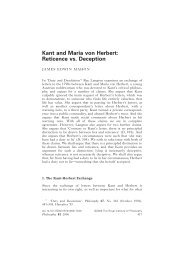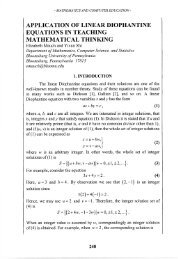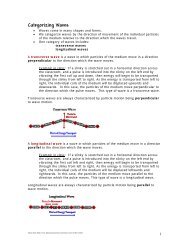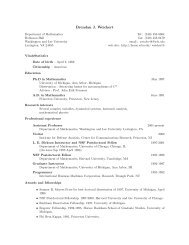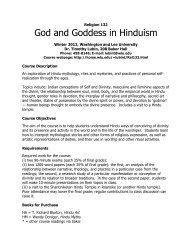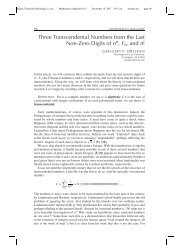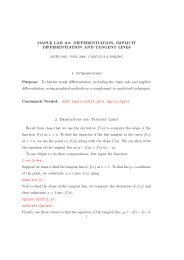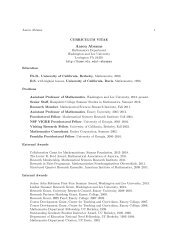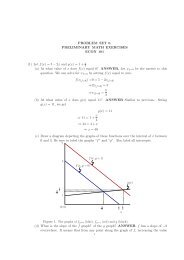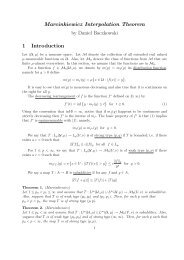comparative assessment of decentralization in africa: ethiopia desk ...
comparative assessment of decentralization in africa: ethiopia desk ...
comparative assessment of decentralization in africa: ethiopia desk ...
- No tags were found...
Create successful ePaper yourself
Turn your PDF publications into a flip-book with our unique Google optimized e-Paper software.
3.0 POLITICAL ECONOMY OFDECENTRALIZATIONIn this section, we address the political decision mak<strong>in</strong>g beh<strong>in</strong>d the <strong>decentralization</strong> process. Asnoted <strong>in</strong> the section on Political Incentives and Constra<strong>in</strong>ts, we f<strong>in</strong>d that the EPRDF hadcompell<strong>in</strong>g political reasons to decentralize <strong>in</strong> the 1990s to ensure governability and facilitate aprocess <strong>of</strong> state reform and democratization. In this, we do not assume that the EPRDF was<strong>in</strong>terested only <strong>in</strong> the ―stated goals‖ <strong>of</strong> <strong>decentralization</strong>, but that it may also have been <strong>in</strong>terested<strong>in</strong> secur<strong>in</strong>g its own power. In any event, we f<strong>in</strong>d that what was good for stability and good for<strong>decentralization</strong> was also good for the party.3.1 POLITICAL INCENTIVES AND CONSTRAINTS: PROPONENTS ANDOPPONENTSRelat<strong>in</strong>g to the question <strong>of</strong> political accountability <strong>in</strong> Section 2.3 above, it may be said that many<strong>of</strong> the central political <strong>in</strong>centives and constra<strong>in</strong>ts beh<strong>in</strong>d <strong>decentralization</strong> are found <strong>in</strong> thepolitical party system, and particularly <strong>in</strong> the dom<strong>in</strong>ance <strong>of</strong> the EPRDF. The power <strong>of</strong> the centralparty <strong>in</strong> the decentralized federation was such that the system orig<strong>in</strong>ally considered a ―hold<strong>in</strong>gtogether‖federation designed to accommodate Ethiopia’s peoples came to be understood bysome as a top-down ―putt<strong>in</strong>g-together‖ federation (Keller and Smith, 2005, p. 269; cf. Stepan,1999). As noted above, the EPRDF <strong>in</strong>itially had <strong>in</strong>centives to accommodate diverse ethnic<strong>in</strong>terests with regional <strong>decentralization</strong>, but these <strong>in</strong>centives shifted as the party consolidatedpower and established its dom<strong>in</strong>ance <strong>in</strong> political life over the period from 1995 to the present.In light <strong>of</strong> its partisan control at all levels <strong>of</strong> the political system, the EPRDF has mixed<strong>in</strong>centives with respect to <strong>decentralization</strong>. In many <strong>in</strong>stances, dom<strong>in</strong>ant parties should bereticent to fragment or fracture their grip on central power through <strong>decentralization</strong>. Whiledecentraliz<strong>in</strong>g could <strong>in</strong>deed result <strong>in</strong> such dispersal <strong>of</strong> power, the extension <strong>of</strong> political authorityto subnational levels has also accommodated large numbers <strong>of</strong> EPRDF party activists and hasclearly deepened the political l<strong>in</strong>kages between the party and local populations. Putaffirmatively, this could enable effective channel<strong>in</strong>g <strong>of</strong> demands from local levels to <strong>in</strong>creas<strong>in</strong>glyhigher levels <strong>of</strong> government (cf. Meheret, 2007, p. 89). But the scholarship on the structure <strong>of</strong>the party itself po<strong>in</strong>ts <strong>in</strong> the direction <strong>of</strong> greater degree <strong>of</strong> state control, clientelism, and top-downgovernance <strong>in</strong> which decentralized units perform more as transmission belts for centralprerogatives than for upward transmission <strong>of</strong> local demands (cf. Aalen and Tronvoll, 2008;Chanie, 2007; Kidane, 2001; <strong>in</strong>ter alia). The political <strong>in</strong>centives for the EPRDF may thus be tocont<strong>in</strong>ue to deepen the exist<strong>in</strong>g <strong>decentralization</strong> <strong>of</strong> governance, partly <strong>in</strong> the <strong>in</strong>terest <strong>of</strong> improvedservice provision, but not necessarily <strong>in</strong> the <strong>in</strong>terest <strong>of</strong> more bottom-up democracy.Bureaucratic politics at the m<strong>in</strong>isterial level is an additional complicat<strong>in</strong>g factor, with some(though not all) m<strong>in</strong>istries and central government <strong>of</strong>ficials resist<strong>in</strong>g or otherwise h<strong>in</strong>der<strong>in</strong>g the<strong>decentralization</strong> process. This can be both a political <strong>in</strong>centive to reta<strong>in</strong> power <strong>in</strong> someETHIOPIA DESK STUDY 19



